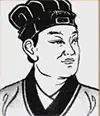Cai Lun and the Invention of Paper
Cai Lun, known as the inventor of what is now paper, lived during the Han period in China. He was born at Leiyang sometime in the middle of the 1st Century A.D. Sources differ on the year of his birth. His family was poor; little more is known about his early life. 
He is known to have been at the emperor's court by A.D. 75. The emperor during that period of the Han Dynasty was He. Cai's reward for helping the young emperor retain his throne by putting down a coup led by Dowager Empress Dou was an appointment heading up the Imperial Supply Department. It was in that capacity in 105 that he made the necessary adjustments to the primitive method of making paperlike writing material to create the first form of what is now recognized as paper. Chinese scribes had written on bamboo and slips of wood for many years before that time. More recent substances for writing included cloth and silk. The former were difficult to write on and keep from deteriorating; the latter were expensive to procure and maintain. 
Cai Lun revolutionized the writing process by introducing a combination of bamboo fishnets, hemp waste, rags, and tree bark. (Many historians think that he began with mulberry trees.) He boiled that combination into a pulp, beat it with a mallet, and then added a bunch of water. A subsequent sieving got rid of most of the water, and he left the paper to dry. Thus is China in general and Cai Lun in particular credited with the invention of paper. Cai survived several changes in emperorship but was forced to give up his government post in favor of a leadership position in a village. Targeted as being part of an alleged plot to kill the emperor An, he chose death by his own hand rather than government execution. He died in 121. |
|
Social Studies for Kids
copyright 2002–2024
David White




